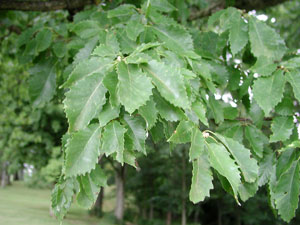Resource Library
Plant of the Week: Oak, Chinquapin
The University of Arkansas System Division of Agriculture does not promote, support or recommend plants featured in "Plant of the Week." Please consult your local Extension office for plants suitable for your region.
Plant of the Week
Chinquapin Oak
Latin: Quercus muehlenbergii

My great grandfather’s Civil War diary reads more like a weather report than a detailed log of his march from Indiana to Atlanta with General Sherman. However, because he was often cold and wet, he commented several times about burning split rail fences as the army marched through Tennessee. Likely some of these fences were made from chinquapin oaks, Quercus muehlenbergii, one of the most widely distributed oaks of North America.
Chinquapin oak is a big tree of the white oak group that ranges from New England, down the Appalachian chain to the Florida panhandle and west to Wisconsin and New Mexico and, in scattered pockets, into Mexico. Nowhere in its range is it found in large numbers, instead it is a component of the diverse eastern American woodland. It sticks to inland sites, avoiding delta regions and the coastal plains of the continent but often attains its largest size in rich bottomland situations along rivers and streams. It is often associated with soils derived from limestone rocks and seems best suited with slightly acidic to neutral pH soils.
Trees are usually 60 to 80 feet tall, and if grown in open places, seen with a broad spreading crown that is almost reminiscent of an American elm. Trees have a moderate growth rate and, though offered in the nursery trade, are not especially common. The trunk is gray-white and similar to white oak or sometimes yellow-tinged.
Leaves of the chinquapin oak are 5 to 6 inches long and one third as wide with 8 to 13 pairs of shallow lobes. Because it belongs to the white oak tribe, the lobes are rounded on the ends, not bristle tipped. The upper leaf surface is a rich green while the undersurface is whitish. Fall color is yellow to orange brown. Its sweet tasting acorns mature in one season and are to an inch long with half of the nut enclosed in the cup.
This oak is named in honor of Gotthif Heinrich Ernst Muhlenberg (1753-1815), the third son of Heinrich Muhlenberg who is considered the patriarch of the Lutheran Church in America. He was born in Pennsylvania but at age 10, was returned to his father’s homeland in modern day Germany for education and training in the clergy. He returned in 1870 and eventually became the pastor of the Lutheran Church in Lancaster, Penn., where he served until his death.
Muhlenberg became interested in botany soon after taking up his role as a minister and collected more than 1,100 plants in and around his home base. Amongst gardeners, he is best known for “Muley Grass,” Muhlenberbia capillaries, which is named in his honor.
Chinquapin oak is a stately tree, but unless it is already growing on the site or a lot of space is available for planting a collection of trees, other faster-growing and more ornamental oaks are available. It is susceptible to most of the ailments of oak but no more so than others of its kind. Young trees can be transplanted but only with a well-formed root ball. Once established, it has good drought tolerance.
By: Gerald Klingaman, retired
Retired Extension Horticulturist - Ornamentals
Extension News - February 8, 2013
The University of Arkansas System Division of Agriculture does not maintain lists of retail outlets where these plants can be purchased. Please check your local nursery or other retail outlets to ask about the availability of these plants for your growing area.